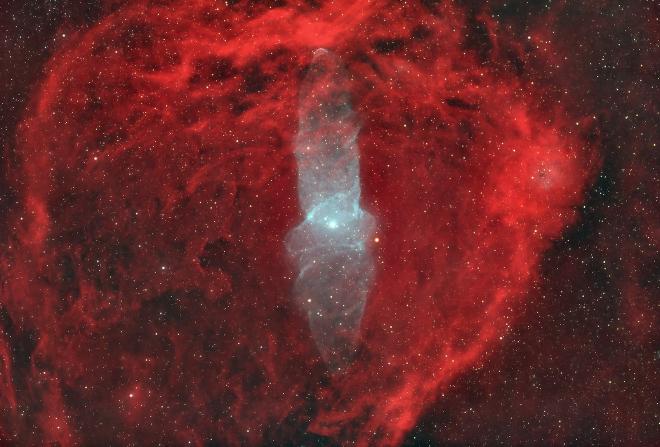SH2-129 Flying Bat (red) and OU-4 Squid Nebulae. The combo can be found in the constellation Cepheus. Both are in the family of emission nebula. The Flying Bat consists of mostly ionized hydrogen gas while the Squid is a region full of ionized oxygen clouds. Due to its extremely dimness, the Squid was discovered only recently in 2011 by French astrophotographer Nicolas Outters. The formation of the Squid is still under debate. But many astronomers believe the bright star HD202214 (near the center of the photo) plays a major role.
Two years into the hobby, I decided to take on the challenge. And, not surprisingly, this is the most demanding project by far. The total integration time is 72 hours. I knew the squid is an extremely faint emission nebula before started. However, it’s more difficult than I expected to get enough photons even in a single 10 min sub for a f/5.3 scope and under Bottle 5/6 skies. Luckily, the weather in Northern California was almost perfect in the past 20 days or so during the project. Cloud coverage was constantly around or below 6-8%, the worst being 12-15%.
Apart from a guiding issue I still need to sort out, imaging the objects was pretty smooth. Processing the data, however, is another story. For my setup, the signal for the squid is not much above the background noise level. Stretching the squid without blowing up the noise was really pushing my processing skills to the limit. I ended up using a mask in order to suppress the noise in the nonlinear stage. All in all, I’ve learned a lot from the project. Hope you will like the results.
Integrated image#

- Telescope: Takahashi FSQ-85EDX
- Camera: ZWO ASI294MM Pro
- Mount: iOptron CEM40
- Filters: Astronomik Deep-Sky RGB 31mm + Astronomik H-alpha 6nm 1.25" + OIII 6nm 1.25"
- Post Processing: Astro Pixel Processor + PixInsight
- Total Integration time: 71h 50'